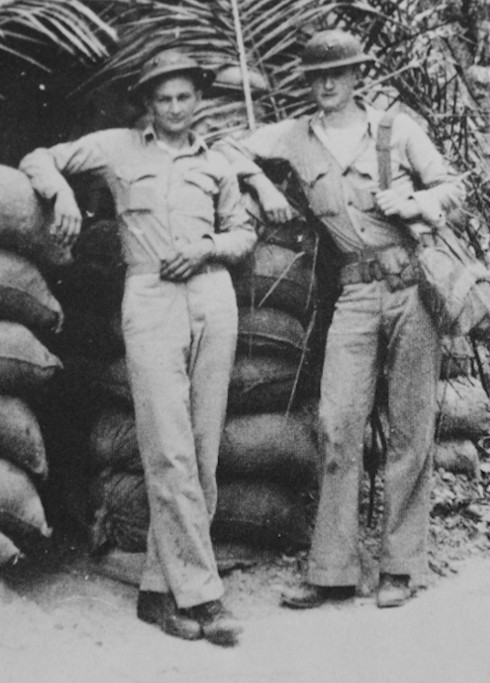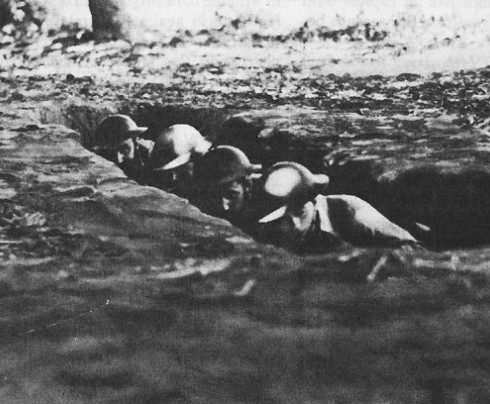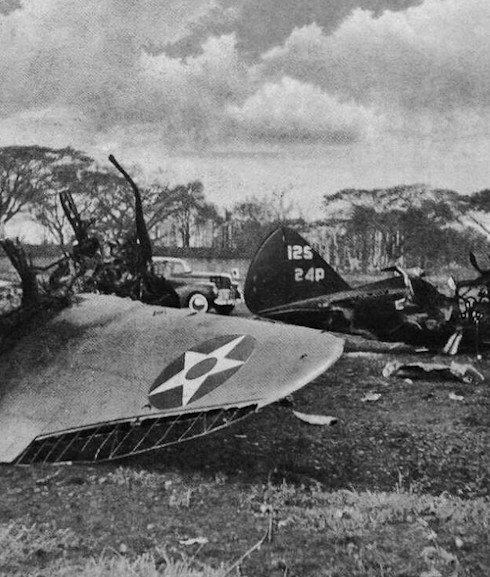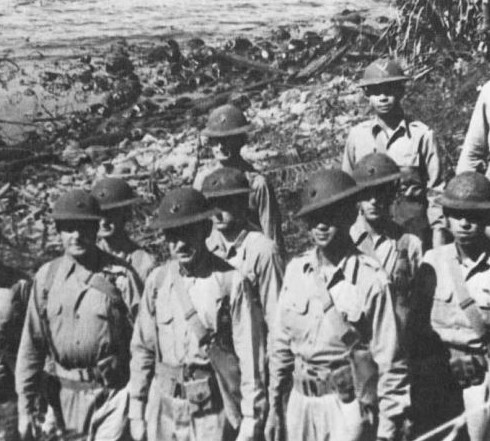

First we went to Olongapo in Subic Bay and ran into a Japanese task force two days out of the Philippine Islands. They were heading for the Philippines, this was going to be the invasion force. They had at least 15 ships: troop ships, destroyers, light cruisers. We had 750 Marines in Shanghai and we had roughly 700 that were stationed in the Philippine Islands in Cavite, so they joined us and we made one unit. So we had roughly 1,500 Marines in the Philippines.
As far as we were concerned, we were on our way home. I don't know how many of those people were going to go, but they really didn't join up with us until the war started. They were still in their regular duties there in the Philippines. But once the war started, we were all consolidated together. But as far as we were concerned, this was just a stop over and we were on our way home. And, of course, a week later, why, then the war started.
At 2:30 in the morning, we heard the bugler sounding call to arms, and, of course, we all woke up, what in the world is going on. They told us that the Japanese had bombed Pearl Harbor and that we were at war. So we all went out on the beach and they gave us 10 rounds of ammunition with our old 3 rifles.
What we had was what we had in Shanghai and what the Marines in 1927 brought with them. These were rifles, grenades, 20 millimeters, machine guns, B.A.R.'s that were actually from World War I. And of course, a lot of our equipment at the time in Shanghai was used for school. We'd tear them down, put them together. Tear them down, put them together. That's what we had during the whole war, six months of war, was the old threes and some of them would shoot and some of them wouldn't shoot. Especially with the grenades that we had. We had a box of, I think, there were 10 grenades in a box and if you threw 10, maybe three would go off. And the rest of them were just dried up because they were never used.
Then they kind of spread everybody out. We got out of the barracks and put pup tents up to where you could kind of disperse yourself. We had PBY's that were stationed at Subic Bay and they were kind of irritating the Japanese because they were going out with 500 pound bombs and dropping them on their ships. One time they did hit one and damaged it pretty bad. So they flew back in one day and then the Japanese, eight Zeros came right in after them, right after they landed. And they just shot them all to pieces and that was our first time that we were under fire. They were running through the Cavite Navy Yard machine gunning and dropping little personnel bombs and half of them didn't go off but some of them did.


Right after that, 28 bombers came over and that was the first time that we were under a aerial bomb attack and that's where I really got a good dose of concussion. Concussion is just like a sack. You blow up a sack and that's when the bomb hits and your body expands and then when it explodes and goes out and then everything just compresses real quick. And if you just happen to be in an area where it bounces off of something, it could kill you real easy.
Of course, we had no helmets at the time and we just stood there watching those bombers come over and we watched the bomb bay doors open up. And we just say, well, what's going on now? And then we could see little black dots coming out and somebody said, well, that's bombs coming down and boy, they just lowered the boom.
Two days after that they evacuated Olongapo, we were put out into the bivouac areas, more or less in the woods, you know, to kind of get out of all that. Then we found out it we were going to Mariveles, which had a dry dock down there for the ships to come in. The Japanese put 300 troops in Mariveles. Brought them in by submarine, with field artillery pieces. The only way that they were found out was, a couple of navy guys were out in the woods, you know, just sky larking around and ran into these Japanese and that's when they started fighting those Japs over there.
We had those 10-inch guns on Corregidor, and, of course, they could square it out on a grid, and they could hit certain grids going down. Eventually they killed them -- some of them committed suicide, the Japanese officers. They killed all 300 of them but they had field pieces. What they were after was that dry dock, they wanted to blow that up. Down on the beach, most of the dead Japanese officers had college class rings, they were educated in the United States.
All of our stuff that we had in our teakwood chests, boxes and everything, they just blew it all up. And then from there we went down, we were trucked to Manila and stayed there and then we went over to Corregidor right after that for beach defense. They wanted all the Marines to go and set up beach defense on Corregidor. We arrived in Corregidor, well, it was December 28th. MacArthur, of course, was the Commander in Chief of the troops in Bataan and his headquarters were on Corregidor at the time.
And the Army was in Bataan and they were doing most of the fighting there. They shuttled us over to Corregidor on December 28th and set up beach defense. Of course, we didn't have enough to do an adequate job. So they supplied us Filipinos and they had about 300,000 of the Filipinos in their section of the army and we got maybe six in each squad to make up the difference. Well, of course, they didn't want to fight. They wanted to go home. And then of course we went through a lot of bombing. They came over and bombed Corregidor.


Our Air Force was destroyed at Clark Field. Macarthur lined them up wing tip to wing tip and they just came in and just like they did on Pearl Harbor, they destroyed the whole thing. We had a few P-40's and a couple of B-17's. But the P-40's, of course, had no superchargers on them so they couldn't fly high altitude, so they would go up and mock the Japanese Zeros and then the Zeros start chasing them.
Then they'd make a run over Corregidor and as soon as they did that, why then everybody would open up on the Jap planes. Some of them even hit the Americans as they were flying. Everybody was trigger happy, you know. Anything that flew, they were going to shoot at.
From what I understand, one of the high Princes from Japan came over to view the war torn area and there were three light bombers and he was in the middle one. Our anti-aircraft guns we had, the highest they would go would be 21,000 feet if they had a long fuse. But most them just had a short fuse, they couldn't go very high. But they came down low enough to where they put one direct shot into the bottom of that middle one and it blew up and blew up the other two. So I can hear the motors now just as they were trying to gun them to get out of the dive they were in. But they shot down all three of them.
MacArthur left in February. They ordered him out. Of course, he took his wife and his child, his furniture. That's what we heard now. Some of them said they were down at the dock when they left, but he took quite a bit of his furniture, personal maid, but he wouldn't take the seriously wounded out. They were left. But he took everybody that was with his staff. They all got to go out and get out of there. They went out first by PT boat and they went down to Mindanao and then from Mindanao, they had a plane down there and got in a B-17 or a PBY, maybe, but they flew him from there to Australia.
That's how he got out. Of course, he said he went all the way with the PT boat, which he's not about to, you know. Corregidor is divided into three areas: Topside, Middleside, and Bottomside. Bottomside where all the docks where and Topside where all the barracks were. And they put us in these barracks, they said, you don't have to worry about this building because it's bomb proof and all this and that.


Well, not long after that, the Japanese came over Corregidor and started bombing. Dive bombers and horizontal bombers and in the meantime we had taken sand bags and put them up -- the front of the building had these arches and we put sand bags up there in case anything hit in front that you'd have some protection. But they went in there and they were strictly after that barracks. They were going to blow that up. And I was in one room in a corner room and a thousand-pound bomb fell and went completely through a two story building. Went completely through three stories, landed at the bottom, and I had pictures of where the bomb went through the roof and everything and it didn't explode. So if it did I'd probably still have been traveling, you know.
Right after that they put us all out at different areas and some beaches. We had to set up our defenses there and put up the barbed wire. We heard that the Americans are going to come over and they're going to bring supplies and replacements and all this and that which they never did. We never did see a ship. A submarine would get in there every now and then, but the ship, we saw one ship come steaming in and a submarine blew it up before it got into the bay. So we were without supplies, replacements, our food was running low, and, of course, we had C-rations and the Army had K-rations, and that dwindled away. They had the Calvary and started eating the horses, you know. They' butcher up the horses and pass that meat around and everything.
Then Bataan fell April the 9th and the Army didn't destroy any of their field artillery pieces and the Japanese just turned them around and started firing on Corregidor. The ones that were on Bataan when it fell, the majority of those made that Death March and they lost, gosh, I guess they lost over 10,000 on that march. Eighty miles with no food or water. If they dropped, they would either bayonet them or shoot them and they even had tanks that would run right over them and just flatten them out.
From April the 9th until May the 6th, why, of course, it intensified pretty good. The bombing picked up. The artillery picked up, and, of course, Corregidor was five square miles and they had 600 guns that completely surrounded Corregidor and they were firing day and night, day and night. Airplanes would come over at nighttime and drop bombs and so it got pretty hectic there the last month.
Defense of the Philippines
December 1941 - May 1942
All quotes attributed to Hold High the Torch: A History of the 4th Marines by Kenneth W. Condit and Edwin T. Turnbladh
"The 4th Marines' first campaign of World War II ended in defeat and captivity. Committed to the defense of Corregidor and Bataan in the Philippines, the regiment, along with the other American and Filipino forces, finally surrendered to overwhelming Japanese strength on 6 May 1942. But the four months of stubborn resistance slowed the Japanese timetable of conquest and won time for the mobilization of American industry and manpower. As a stimulant to sagging morale, the Philippine campaign was equally important. Not since the Alamo had such inspiration been drawn from a battle lost. Though defeated, the American soldiers, sailors, and Marines, by their heroic defense against overwhelming odds, inspired their comrades in arms and the civilians back home to redouble their efforts for final victory."
"The Japanese, meanwhile, took advantage of commanding positions on Bataan to emplace an overwhelming force of artillery with which to batter the defenses of Corregidor. At least 37 batteries, with weapons ranging from 75 to 240mm were employed. 22 Enemy artillerists on Bataan, aided by aerial spotting, had every inch of the island under observation, and they took advantage of it to blanket the "Rock" with artillery fire. As the American antiaircraft guns were knocked out, Japanese pilots became increasingly bold, swooping ever lower to pinpoint their targets for bombing attacks. The shelling and bombing never really stopped.
" . . . . Casualties of the Marines for the entire Philippines campaign totalled 331 killed in action, died of wounds, and missing and presumed dead, and 357 wounded in action. With the surrender, the regiment ceased to exist, but the spirit of the 4th lived on among those Marines who had served in it in happier days. That a new 4th would be created to carry on the traditions of the old and to redeem its honor in total victory over the Japanese, was practically a certainty from the dark moment on 6 May when Colonel Howard burned the regimental colors and led his Marines into captivity."
Read Hold High the Torch